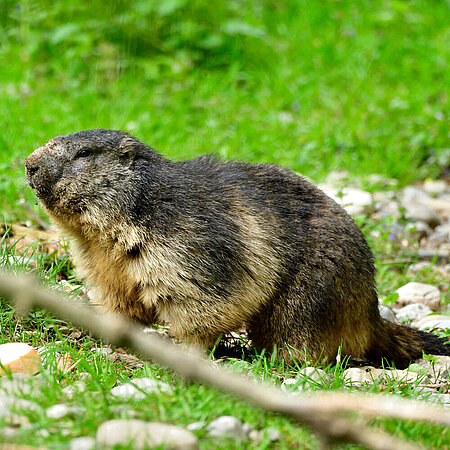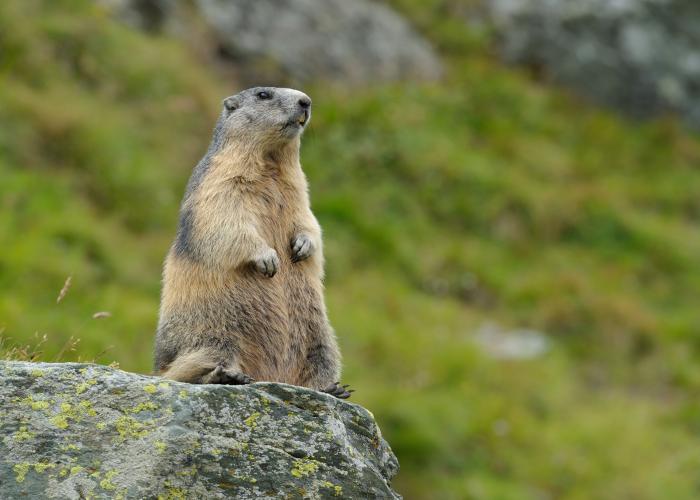Introduction
The Alpine Marmot is an intriguing mammal that inhabits the mountainous regions of Europe. Known for its stocky build, short legs, and social nature, this species has captured the interest of wildlife enthusiasts and researchers alike.
The purpose of this article is to provide a comprehensive overview of the Alpine Marmot, covering its physical description, habitat and distribution, behavior and lifestyle, diet and feeding habits, reproduction and life cycle, as well as its conservation status. By delving into these aspects, we aim to deepen your understanding of this captivating creature and foster an appreciation for its unique place in the natural world. Join us on this exploration of the fascinating world of the Alpine Marmot.
Physical Description of the Alpine Marmot
The Alpine Marmot is a medium-sized rodent with several distinct physical features that set it apart. Let’s delve into its size, appearance, and fur characteristics:
A. Size and Appearance:
The Alpine Marmot typically measures around 18 to 24 inches (45 to 60 cm) in length, excluding the tail.
It has a robust and stocky build, with a rounded body and short, sturdy legs.
Adult Alpine Marmots usually weigh between 5 to 10 kilograms (11 to 22 pounds), with males being slightly larger than females.
B. Distinct Features:
One of the most noticeable features of the Alpine Marmot is its short legs, which are perfectly adapted for digging burrows and navigating rocky terrains.
It has a rounded head with small, round ears and a blunt, yet expressive snout.
The marmot’s front paws are equipped with sharp claws, ideal for excavating burrows and foraging.
C. Fur Coloration and Texture:
The Alpine Marmot’s fur is dense and consists of two distinct layers: a coarse outer layer and a soft, insulating underlayer.
The fur coloration varies depending on the season. In summer, the fur is predominantly brown with shades ranging from reddish-brown to grayish-brown.
During the winter months, the fur changes, becoming thicker and grayer to provide better insulation against the cold alpine environment.
The unique combination of the Alpine Marmot’s stocky build, short legs, and adaptable fur enables it to thrive in the challenging mountainous habitats it calls home.

Habitat and Distribution
The Alpine Marmot is well-adapted to mountainous environments and can be found in specific regions across Europe. Let’s explore its natural habitat and geographical distribution:
A. Natural Habitat:
The Alpine Marmot is primarily found in high-altitude mountainous regions, typically above the tree line.
It prefers areas with meadows, grasslands, and rocky slopes, where it can find suitable burrowing sites and a diverse range of alpine vegetation for sustenance.
These habitats provide the marmots with the necessary resources, such as food, shelter, and protection from predators.
B. Geographical Distribution:
The Alpine Marmot is native to the mountainous regions of central and southern Europe.
Its range extends across several countries, including Switzerland, Austria, Italy, France, Germany, and Slovenia.
Within these countries, the marmots are found in specific alpine regions, such as the Swiss Alps, the Italian Dolomites, the French Alps, and the Bavarian Alps.
While the Alpine Marmot has a relatively limited distribution, it has managed to thrive in its specialized mountain habitats. Its ability to adapt to the challenging conditions of these environments is a testament to its resilience and unique ecological niche.
Behavior and Lifestyle
The Alpine Marmot is known for its social nature and fascinating behaviors. Let’s explore its colony-based lifestyle, burrowing behavior, and hibernation habits:
A. Social Nature and Colony Living:
Alpine Marmots are highly social creatures and typically live in colonies called “marmot colonies” or “marmot towns.”
These colonies can consist of several individuals, ranging from a few to over a hundred marmots, depending on the availability of resources.
Within the colony, there is a complex social structure with dominant individuals, breeding pairs, and subordinates.
B. Burrowing Behavior and Tunnel Systems:
The Alpine Marmot is an excellent digger, and burrowing is a fundamental aspect of its behavior.
They create intricate tunnel systems in the ground, which serve as their shelters, protection against predators, and safe spaces for rearing their young.
These burrows can extend several meters in length and feature multiple entrances and chambers for different purposes.
C. Hibernation Habits and Winter Preparation:
Alpine Marmots are true hibernators and spend a significant portion of the year in hibernation.
As winter approaches, they start preparing by consuming large amounts of food to build up fat reserves.
When the colder months arrive, they retreat to their burrows and enter a state of hibernation, conserving energy and surviving on their fat stores until spring.
The social dynamics, burrowing behavior, and hibernation habits of Alpine Marmots are fascinating aspects of their lives. These behaviors not only help them survive in their mountainous habitats but also contribute to their unique ecological role within alpine ecosystems.
Diet and Feeding Habits
The Alpine Marmot is a herbivorous species with a specialized diet. Let’s explore what they eat and how they gather food for storage:
A. Herbivorous Diet:
The Alpine Marmot primarily feeds on a variety of grasses, alpine plants, herbs, and shrubs.
They are well-adapted to extract nutrients from coarse vegetation, including tough grasses found in their alpine habitats.
Their diet also includes roots, bulbs, and leaves of alpine plants, providing them with the necessary nutrients for survival.
B. Foraging Behavior and Food Storage:
Alpine Marmots are active foragers and spend a significant amount of time searching for food.
They use their keen sense of smell and agility to locate and access food sources.
Marmots have cheek pouches that allow them to gather and carry food back to their burrows.
They store food in underground chambers within their burrow systems, creating food caches that they rely on during periods of scarcity, such as winter hibernation.
The Alpine Marmot’s ability to extract nutrition from alpine vegetation and their efficient food storage strategies are vital for their survival in the challenging mountainous habitats they inhabit. Their herbivorous diet plays a crucial role in shaping their behavior and ecological interactions within their alpine ecosystem.

Reproduction and Life Cycle
The Alpine Marmot follows a specific reproductive cycle and exhibits unique behaviors related to reproduction. Let’s explore their mating habits, gestation period, birth of young, and parental care:
A. Mating Habits and Reproductive Cycle:
The mating season for Alpine Marmots usually occurs in spring, typically between April and May.
Males engage in intense competition for access to females, engaging in vocalizations and physical displays to establish dominance.
Once a male successfully mates with a female, they form a monogamous breeding pair for the season.
B. Gestation Period and Birth of Young:
The gestation period for Alpine Marmots lasts approximately 30 to 32 days.
Females give birth to a litter of usually 3 to 5 young, known as pups.
The pups are born blind, hairless, and completely dependent on their mother for survival.
C. Parental Care:
Both male and female Alpine Marmots contribute to the care of the young.
The female provides nourishment through nursing, and the male assists in protecting and monitoring the burrow.
The parents play a crucial role in teaching the pups essential skills such as foraging, social interactions, and burrow maintenance.
As the pups grow, they gradually become more independent but continue to receive parental guidance and support.
The reproductive cycle and parental care exhibited by Alpine Marmots demonstrate their strong family bonds and cooperative breeding behaviors. These behaviors contribute to the survival and success of the offspring, ensuring the continuity of the species in their alpine habitats.
Conservation Status
The Alpine Marmot has a relatively stable population and is not currently considered to be globally threatened. However, it is important to monitor and address potential threats to ensure the long-term survival of the species.
A. Conservation Status:
The International Union for Conservation of Nature (IUCN) currently categorizes the Alpine Marmot as a species of “Least Concern.”
This classification indicates that the species is not facing an immediate risk of extinction at a global level.
B. Threats and Challenges:
Despite their relatively stable population, Alpine Marmots face some threats and challenges in their natural habitat.
Fragmentation and loss of suitable alpine habitats due to human activities, such as infrastructure development and tourism, can disrupt their populations.
Climate change and alterations in alpine ecosystems may also impact their food availability and alter the timing of key life cycle events.
C. Conservation Efforts and Initiatives:
Several conservation efforts and initiatives are in place to protect the Alpine Marmot and its habitat.
These include the establishment of protected areas and national parks where the species can thrive undisturbed.
Research projects are conducted to monitor their population dynamics, behavior, and habitat requirements.
Public awareness campaigns and educational programs aim to promote the conservation of the Alpine Marmot and its alpine ecosystem.
Continued monitoring, habitat conservation, and public awareness are crucial for ensuring the long-term survival of the Alpine Marmot and preserving the unique alpine habitats it depends on. By implementing conservation measures, we can mitigate potential threats and secure a sustainable future for this fascinating species.
Conclusion
The Alpine Marmot is a captivating species that thrives in the challenging mountainous habitats of Europe. Throughout this article, we have explored various aspects of their physical description, habitat, behavior, diet, reproduction, and conservation status. Let’s summarize the key points discussed:
The Alpine Marmot has a robust build, short legs, and dense fur, making it well-adapted for its alpine environment.
They inhabit mountainous regions above the tree line, where they create complex burrow systems and live in colonies.
Their herbivorous diet consists of grasses, alpine plants, and shrubs, and they gather and store food in their burrows.
Alpine Marmots are social animals, exhibit monogamous breeding pairs, and provide parental care to their young.
The species is currently classified as “Least Concern” but faces threats from habitat loss and climate change.
Conservation efforts, including protected areas and research initiatives, are in place to safeguard their population.
The Alpine Marmot is not only a unique and fascinating species but also an important contributor to its alpine ecosystem. Their burrowing behavior helps maintain soil structure and their herbivory shapes plant communities. By appreciating these incredible creatures, we can develop a deeper understanding of their ecological role and the delicate balance of the alpine ecosystems they inhabit.
I encourage readers to further explore and appreciate the Alpine Marmot in the wild. By learning about their behaviors, observing them in their natural habitat, and supporting conservation efforts, we can contribute to their preservation and the protection of their alpine ecosystems for generations to come.






